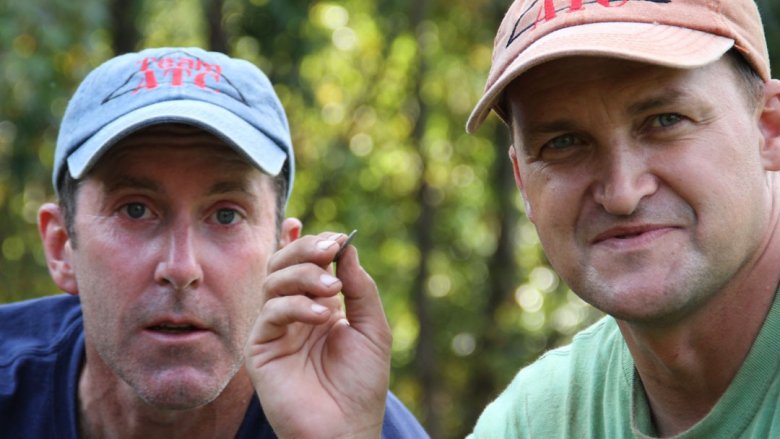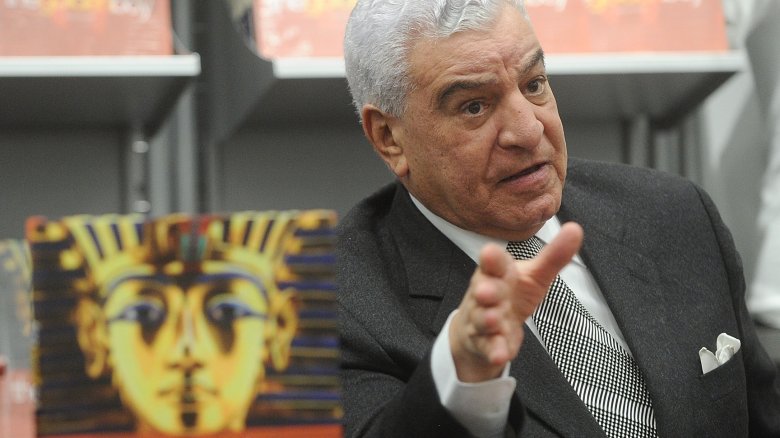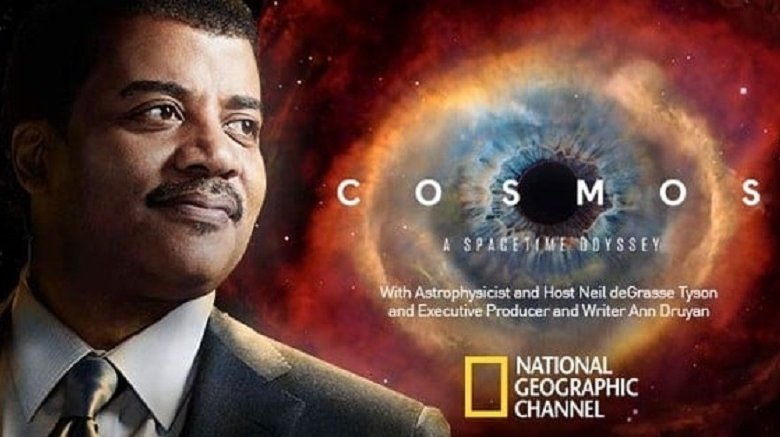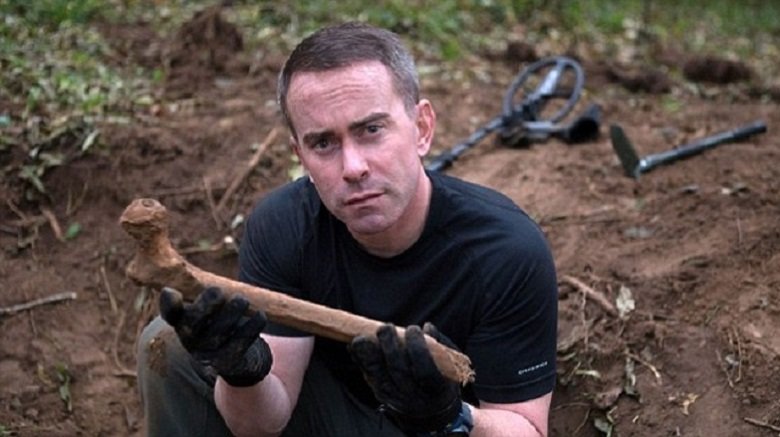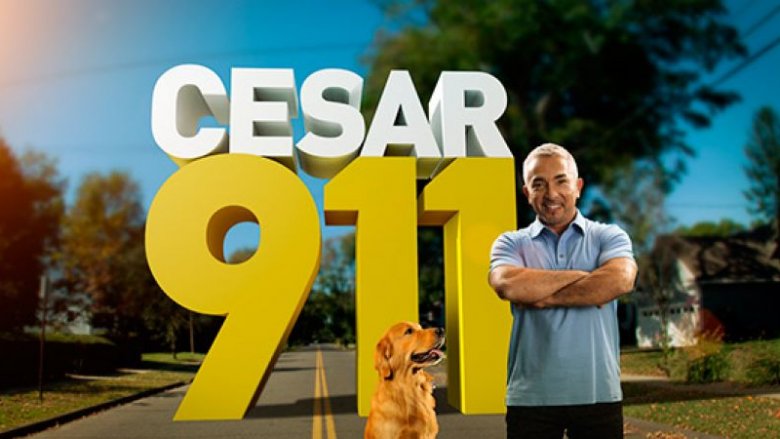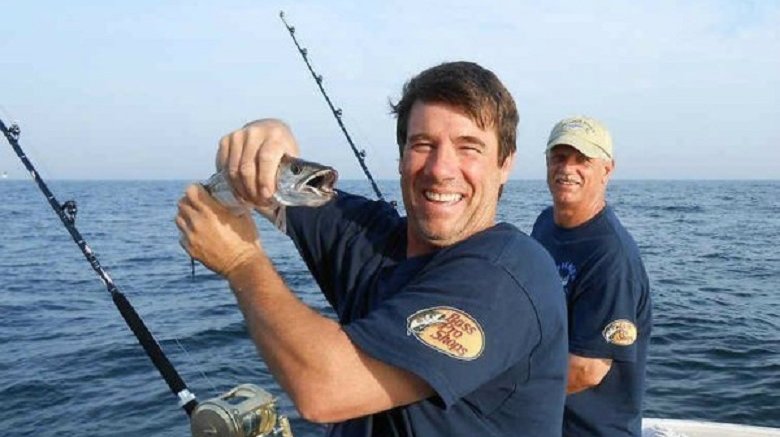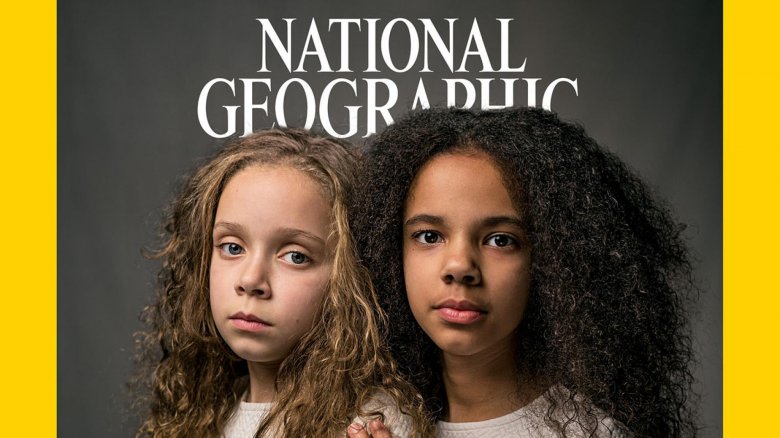The Biggest Scandals To Ever Hit National Geographic
With some of the most popular shows on cable TV, plus the brand recognition of a magazine that's more than 125-years-old, just about everyone has either heard of National Geographic or watched at least one of their many shows. And National Geographic is one of the most popular educational networks in the world, so you'd think everything would be squeaky clean, right? If it's educational, then it must be completely on the up-and-up!
Not exactly. With over a century of history to their name, National Geographic has, naturally, found plenty of time to involve itself in a number of dark and dirty scandals, from illegal to unethical to just plain wrong. When you peer into the depths of that friendly yellow rectangle, you'll find things you probably never, ever expected. Here are just a few reasons why the National Geographic channel (and even sometimes the magazine) is way shadier than you ever would have imagined.
National Geographic's Dr. Pol was charged with negligence
National Geographic's The Incredible Dr. Pol, first broadcast in 2011, features Dr. Jan Pol, a Michigan veterinarian with decades of experience. But in October 2012, something not-so-incredible happened. Dr. Pol was fined and placed on probation for negligence and incompetence, according to DVM360. The charges stemmed from how his office handled a pregnant dog named Mocha.
Mocha, a German shorthair, was expected to deliver on April 3, 2010. When Mocha didn't go into labor, her owners called Dr. Pol's office multiple times, each time being told to wait and "let nature take its course." On April 12, nine days after Mocha's expected due date. Dr. Pol's office finally conducted an ultrasound and claimed to see movement, again telling the family to wait.
The owners got a second opinion from another vet. This vet performed their own ultrasound, saw no movement, and performed a C-section on Mocha, where they found ten stillborn puppies that had been dead for several days. It was basically all Dr. Pol's fault, because after an administrative complaint was filed, the Michigan Department of Licensing and Regulatory Affairs Bureau of Health Professions Board of Veterinary Medicine found he'd "failed to accurately read a canine ultrasound, [and] appropriately treat the patient." He was fined $500 and ordered to complete several educational courses. National Geographic stood behind Dr. Pol and continued the show in spite of the incident. In 2019, it was still one of their highest rated programs.
Archaeologists did not dig National Geographic's Diggers
If there's one important thing in archaeology, it's being an actual archaeologist and not just someone who likes to dig holes willy-nilly. You can probably guess which kind of person was involved with the National Geographic series, Diggers. According to the Billings Gazette, the show was roundly criticized by experts, for featuring two men, "King George" Wyant and Tim "The Ringmaster" Saylor, who had no professional certifications between them, but were avid users of metal detectors.
The two would visit various sites and try to find buried treasure using their metal detectors and standard digging equipment. There are two problems here. First of all, digging in various spots on a piece of property, even with permission, can run afoul of the law, especially if an actual item is excavated (in which case it might be subject to various ownership issues). The second problem is environmental factors. Actual archaeologists are very careful where they dig and how, so as not to upset the environment of a local area. Wyant and Saylor weren't bother by those kinds of details.
After three seasons of digging with reckless abandon and endless controversy, Forbes reported National Geographic finally collaborated with The Society for American Archaeology (SAA) to establish guidelines and retool the show. Unfortunately, the show was cancelled shortly after, though the SAA maintains their recommendations did not lead to lower viewership.
Doomsday Preppers edited out a creepy guest
One of National Geographic's most popular shows to date, Doomsday Preppers never shied away from featuring some colorful characters, to put it mildly. The show focused on survivalists who spent a really outsized amount of time preparing for an apocalypse that might never come, so unusual guests were a pretty normal part of the show, but only one was edited completely out of a completed episode.
During production for season three, the show filmed segments with James Yeager, a West Tennessee man and CEO of a firearms training company. The segments were planned to go to air, but it came out Yeager made a YouTube video several months earlier railing against the government and threatening to "start killing people" if his second amendment rights were infringed. This caused so much widespread outrage that Yeager's firearms carry permit was suspended by the State of Tennessee, according to USA Today.
Later that same year, when National Geographic indicated Yeager would appear on Doomsday Preppers, The Coalition to Stop Gun Violence (CSGV) protested, calling Yeager a "violent pro-gun extremist." National Geographic felt the pressure and publicly agreed not to air Yeager's segments, according to a report by WBBJ News. They were edited out of the final episode, with National Geographic explaining while they gave the show's producers liberty to conduct hundreds of interviews to gather content for each season, Yeager did not fit the show or network's sensibilities.
A religious colony accused National Geographic of being exploitative
In 2012, National Geographic aired a 10-part miniseries called American Colony: Meet the Hutterites. Hutterites, if you're not familiar with them, are a group somewhat like the Amish or Mennonites. They live in relative isolation and avoid technology. Despite this, initially Hutterite bishops agreed to let National Geographic film in one of their Montana colonies, King Ranch Colony, and gave permission for followers to speak freely to the cameras. After the show aired, however, the Bishops were outraged, demanding that the network apologize, as reported by the Associated Press, and King Ranch members who participated feared being shunned.
What happened? According to Hutterite bishops, National Geographic and producer Jeff Collins manipulated and exploited the colony. Colonists complained the show was meant to be a serious look into Hutterite life, but the network instead invented fake, overdramatic storylines and gave them scripted lines to read.
In The Washington Post, National Geographic insisted they had filmed things as they happened and that they saw a lot of conflict there, especially between young Hutterites and King Ranch Colony elders. The network didn't back down, but they did point out they paid the colony $100,000 to film there.
National Geographic got caught bribing a foreign entity
On any National Geographic show about Ancient Egypt, you're likely to see a man named Dr. Zahi Hawass. Hawass (pictured) was Egypt's Minister of State for Antiquities Affairs under President Hosni Mubarak, who was overthrown in 2011 as part of the Arab Spring protests, so he definitely had some credentials. Even after Mubarak's downfall, Hawass retained his job under the new government's Prime Minister Essam Sharaf, though he mysteriously resigned a few months later. He's still a very prolific speaker and writer about Ancient Egyptian history and artifacts.
Obviously, such a highly regarded Egyptologist would be a big get for National Geographic, and they clearly thought so as well, as they were caught paying Hawass $80,000 to $200,000 a year in bribes, according to The Independent, for special access to artifacts and sites, which is very illegal under US law. Hawass insisted everything was above-board and it was part of his job as Explorer-in-Residence for National Geographic (the magazine and the network), a position previously held by names such as primatologist Jane Goodall and filmmaker James Cameron. This didn't stop a US investigation against National Geographic.
In the meantime, Hawass had other issues on his plate, such as accusations of unprofessional behavior and impropriety in his home country of Egypt, not to mention heavy criticism for being a massive antisemite. As a result of the investigation, he did end his relationship with National Geographic, but no formal charges were ever brought.
Neil deGrasse Tyson was accused of sexual misconduct
The internet's most beloved astrophysicist, Neil deGrasse Tyson, has been a mainstay on National Geographic in recent years. His StarTalk show brings in experts and other guests from all over the world to, y'know, talk about stars. He even had a show, Cosmos, on National Geographic's sister channel, Fox (both are now owned by Disney). A sequel to Carl Sagan's Cosmos series from the 1980s, it features Tyson exploring both the science and philosophy of astrophysics along with some fancy CGI. And it's inexplicably produced by Seth MacFarlane of Family Guy, for some reason.
All of that came to a halt in December 2018, though, when Tyson was accused of sexual misconduct by three women, as reported by The Verge. One, a fellow student from Tyson's grad school days, alleged he raped her, and the two other women, one a fellow scientist and the other Tyson's former assistant, accused him of making unwanted advances.
National Geographic and Fox suspended both shows while they investigated. According to the Hollywood Reporter, Tyson denied the accusations, but agreed to fully cooperate with the investigation. Three months later, in March 2019, National Geographic and Fox released a statement saying Tyson would be returning to work. They never said what the investigation uncovered, but whatever it was, it was apparently enough to satisfy them.
National Geographic aired a movie as a cheap political stunt
When you think of National Geographic, you think of feature films, right? No? Neither does anyone else, but that didn't stop them from purchasing the rights to 2012 a film called SEAL Team Six: The Raid on Osama bin Laden, a fully-completed film that had been on track for a theatrical release. Hollywood was a bit mystified. National Geographic had never bothered with movies in the past, so why now, and why this particular one? This was a legit studio film. It had William Fitchner and Xzibit in it, people you've actually heard of. It was even produced by the Weinstein Brothers (before... uh, you know).
Soon, though, a Variety report revealed all. National Geographic announced they'd exclusively air the movie on their channel on November 4, 2012, which just happened to be two days before the Presidential election. What a coincidental date for an exclusive release of a film about the killing of Osama bin Laden. Which President was that under again?
Critics on both sides of the spectrum called this out as eye-rollingly transparent, cheap, and sleazy, but National Geographic went ahead with it anyway according to The Atlantic, and presumably laughed all the way to the bank, because it was their biggest program all year.
Nazi War Diggers had some skeletons in its closet
If Indiana Jones taught us anything about digging up Nazi artifacts, it's that you shouldn't do that because your face will melt. But at least Dr. Jones was an actual professional, unlike the people behind the ill-conceived miniseries, Nazi War Diggers. In a similar vein to National Geographic's Diggers, Nazi War Diggers included several people tangentially involved with antiquities and collecting, but not actual archaeologists. The premise of the show was that the cast would visit World War II battlefields and hunt for lost relics.
There's a big problem there, which National Geographic may not have considered. Battlefields, especially ones related to one of the bloodiest wars in history, have a lot of dead bodies. In case you're from Mars, Earth societies generally frown upon disturbing people's final resting places, so if it must be done, we prefer it to be done with respect. This didn't stop National Geographic, though. In a trailer for the show, they showed a cast member pulling human remains out of the ground with their bare hands, as reported by Bloomberg. Not only is this quite disturbing, it's probably pretty unsanitary, too.
Critics called the footage, and the concept of the show itself, ghoulish. After intense pressure, The New York Times' Arts Beat reported National Geographic canned the series and never aired it. However, the show eventually aired overseas on other networks under the name Battlefield Recovery, where it garnered no less controversy.
Cesar Millan was investigated for animal cruelty
Famous dog trainer Cesar Millan has been with National Geographic basically since the network's inception. His show, Dog Whisperer with Cesar Millan, ran for nine seasons and another show, Cesar 911, was on for three. While the shows got excellent ratings, he wasn't so popular with veterinarians and animal behaviorists, according to the New York Times.
In a 2016 episode of Cesar 911, Millan was treating a dog named Simon, who very obviously did not like pigs. He had previously attacked and killed two pet pot-bellied pigs. In a clear example of "what on earth were you thinking?", Millan decided as part of the treatment, he would introduce Simon to a new pig, and penned them both together. What happened next surprised no one, ever. Simon attacked the pig immediately as reported by the BBC, causing its ear to bleed. That may not sound like much, but Simon had previously bitten a pig's ear off completely, as mentioned in The Washington Post. The dog was then restrained, and the pig recovered, but authorities still investigated after seeing the footage. Turns out, putting a pig in a pen with a dog that's known to attack pigs might be considered animal cruelty, and Millan was investigated for the incident.
National Geographic stood up for Millan, saying the pig had healed quickly and showed no signs of distress. In the end, the charges were dropped, but Millan hasn't been featured on National Geographic since.
A captain on Wicked Tuna committed fraud
The National Geographic show Wicked Tuna is sadly not about cursed tuna sandwiches, but is instead about Massachusetts fishing boats hunting for bluefin tuna. The show's concept in and of itself has been the topic of some contention, as bluefin tuna are not technically endangered under U.S. law, but are listed as endangered by the International Union for Conservation of Nature. The show features multiple fishing boats competing with one another to catch the tuna, which can fetch a high price at market. Paul Hebert, captain of The Wicked Pissah (yes, that's his boat's real name), has been featured on the show since the beginning, in April 2012. Remember that date.
In 2009, Hebert applied for Social Security disability, saying he was unable to walk properly or lift heavy weights, according to NBC Chicago. The application was approved, and Hebert collected benefits from 2010 to 2013. What got him caught? He was literally working, and on TV no less, walking and lifting heavy weights while captaining a fishing boat. And he continued to collect the entitlements well after the show premiered.
He was charged in federal court with fraud, to which he pleaded guilty and, according to Page Six, received four years of probation and was required to pay over $50,000 in restitution as well as a $5,000 fine. The moral of this story is, if you're going to commit disability fraud, don't do it while you're starring on a popular TV show.
National Geographic magazine has a history of fakes
The National Geographic magazine isn't immune to controversy. In its over century-long history, it has been a view into the world around us, showcasing natural sciences, anthropology, and more. It has also featured several fakes and forgeries. Always a pioneer, National Geographic was one of the first magazines to have a Photoshop scandal, over half a decade before Photoshop was even a thing.
Before the first internet commenter would cry "Shopped!" (and before internet comments in general), the February 1982 cover of National Geographic featured a photo of the Pyramids of Giza. Using early digital editing, National Geographic reformatted the pyramids to appear closer on a vertical magazine cover, versus the horizontal layout of the original (pictured above). Hardly anything earth-shattering now, but a huge deal at the time when ethics around digitally manipulated images had yet to be established. So you'd think the magazine would be more aware of edited photos since then, right? You would be wrong. They've featured countless faked and manipulated photos in the intervening decades, even on into 2019.
Perhaps their biggest failure when it comes to fakes wasn't about images, but when the magazine heavily promoted a fossil they called Archaeoraptor liaoningensis, which they claimed bridged the gap between dinosaurs and birds. Naturally, it turned out to be a forgery, according to Scientific American, a manufactured fossil from China several peer-reviewed publications had already rejected.
National Geographic magazine apologized for how racist it was
In over 125 years of existence, National Geographic had a storied legacy, with countless awards and accolades. But perhaps their biggest, most lasting legacy is their history of racism. In 2018, editor-in-chief Susan Goldberg published an editorial outlining the very deeply racist coverage the magazine had had for most of its lifespan. She specifically called out their depiction of other races as "exotic" or "noble savages" and how the publication had a tendency to ignore people of color in the U.S., not even really acknowledging they existed until the 1970s.
During an investigation of the magazine's archives, outside researcher John Edwin Mason of the University of Virginia even found captions in an old issue referring to black Australian Aborigines as "savages" and claimed they "rank[ed] lowest in intelligence of all human beings," according to the BBC.
After this great airing of dirty laundry, however, critics have still found plenty of racist coverage to remark on, such as a cover asking "Whose land is it anyway?" referring to the American West and having a big picture of a cowboy next to it only six months after Goldberg's editorial, or a privacy-invading photo featuring families in their roofless homes in India, along with a caption that said "Can you spot the curry?" that actually won an award (while Goldberg was editor) just a few months before National Geographic's sudden racial introspection.


